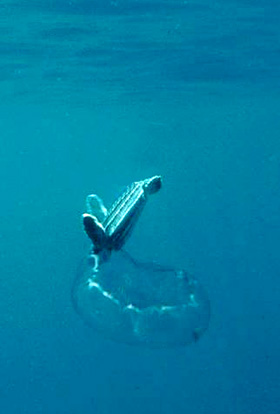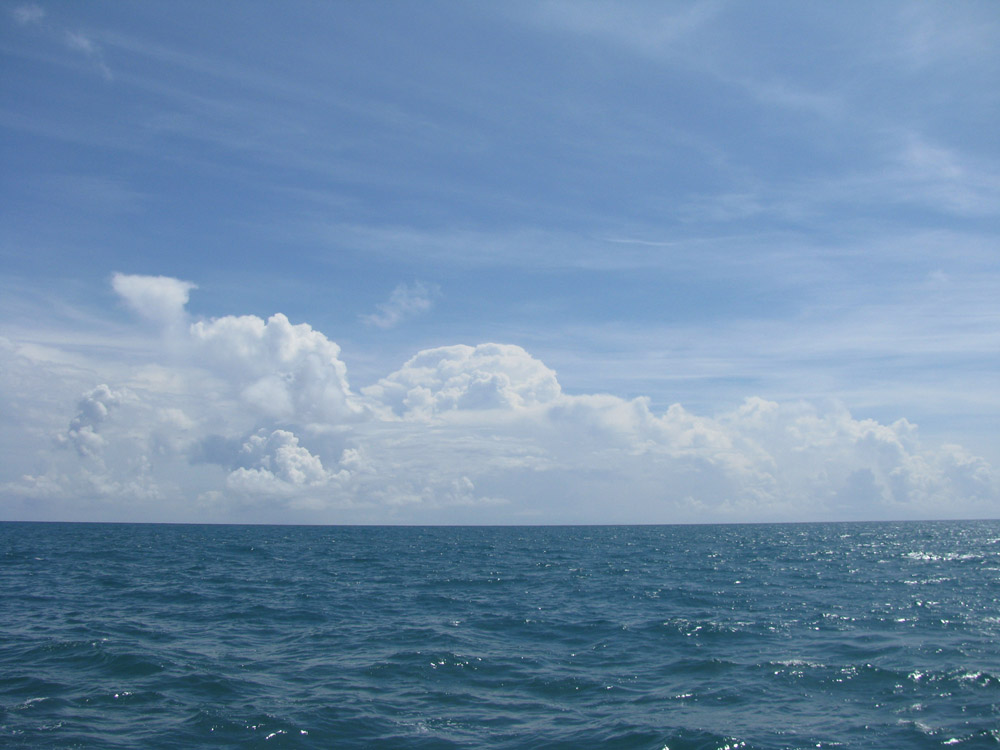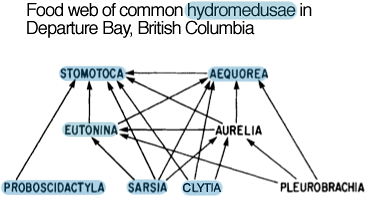Interactions
Most of the interactions that the Aequorea victoria has with other species are predatory by nature. The Cnidarian polyp stage has different interactions than the medusa stage with other species (for more information on the polyp stage click here). Certain kinds of Cnidarians, like the Proboscidactyla flavicirratae which inhabits the outside rim of sabellid worms, form a parasitic relationship. The polyp eats unicellular algae and certain larval crustaceans that wonder near the worms. In certain cases, they are capable of eating much larger prey such as copepods, nematoades, and the worm’s eggs (A Snail's Odyssey, 2010). The polyp phase for Aequorea victoria is very limited on movement and therefore relies on prey to float close enough to the tentacles so it can capture them. The polyps diet consist almost entirely of zooplankton and small fish that float by. The medusas, which float in currents and are capable of moving around, have a greater variety of food than the immobile polyp. The medusas diet contains not only zooplankton, but also invertebrate eggs (click here for an example of an invertebrate) and tintinnids, Mero-plankton, Copepods, and larvaceans (Purcell, 1991). Aequorea victoria has no problem with devouring most of the organisms it preys on, but as the competition between predator and prey is continuously changing, certain organisms have learned how to escape from the grasp of Aequorea victoria. Aglantha digitale and Proboscidactyla flavicirrata have developed different methods that are effective against Aequorea victoria. Aglantha digitale uses a burst of speed from swimming while Proboscidactyla flavicirrata uses a defensive technique that causes them to “crumple” (Purcell, 1991).
Figure 1. A food web that shows the interaction of common
hydromedusae found in Departure Bay, British Columbia. The chart
shows that Aequorea species prey on other types of jellyfish but are
not commonly preyed on. According to the study by Dr. Thomas
Carefoot, of the studied species, members of the genus Stomotoca
were the only known predator of Aequorea victoria
that are hydromedusa
 The
most common predator of species of cnidarians are other species of
cnidarians (fig. 1). The special interaction that involves predation
between the species of cnidarians is
known as intraguild predation. Intraguild predation is the
“eating of species that use similar, often limiting, resources,
and are thus potential competitors” (Purcell, 1991). Species
such as Eutonia indicans, Phialidium gregarium, and
Sarisia
tubulosa are other species of cnidarian that are also consumed
by Aeqourea victoria (Purcell, 1991). Most Jellyfish, including
Aequorea victoria, are capable of repelling would be predators
thanks to its stinging tentacles, but certain animals are
capable of preying on the jellyfish. Adaptations have allowed
certain organisms, such as the Leatherback sea turtle and sunfish
for example, are capable of eating the jellyfish and extracting
nutrients. The leatherback sea turtle has developed rough skin
that is not penetrated by the stingers of the jellyfish (Heaslip, 2012). Researchers are still trying to figure out how
the eyes and the mouth are unaffected by the stingers, but all
that is known is that the venom does not affect the sunfish or
the leatherback turtle (Heaslip, 2012).
The
most common predator of species of cnidarians are other species of
cnidarians (fig. 1). The special interaction that involves predation
between the species of cnidarians is
known as intraguild predation. Intraguild predation is the
“eating of species that use similar, often limiting, resources,
and are thus potential competitors” (Purcell, 1991). Species
such as Eutonia indicans, Phialidium gregarium, and
Sarisia
tubulosa are other species of cnidarian that are also consumed
by Aeqourea victoria (Purcell, 1991). Most Jellyfish, including
Aequorea victoria, are capable of repelling would be predators
thanks to its stinging tentacles, but certain animals are
capable of preying on the jellyfish. Adaptations have allowed
certain organisms, such as the Leatherback sea turtle and sunfish
for example, are capable of eating the jellyfish and extracting
nutrients. The leatherback sea turtle has developed rough skin
that is not penetrated by the stingers of the jellyfish (Heaslip, 2012). Researchers are still trying to figure out how
the eyes and the mouth are unaffected by the stingers, but all
that is known is that the venom does not affect the sunfish or
the leatherback turtle (Heaslip, 2012).
Aequorea victoria also has a unique, but indirect, affect on people. Thanks to the efforts of Osamu Shimomura, Martin Chalfie, and Roger Tsien, scientists are now able to use GFP for medical purposes (Mills, 2008). To learn more about GFP and the Bioluminescence of Aequorea victoria, click the Interesting Facts button below!

